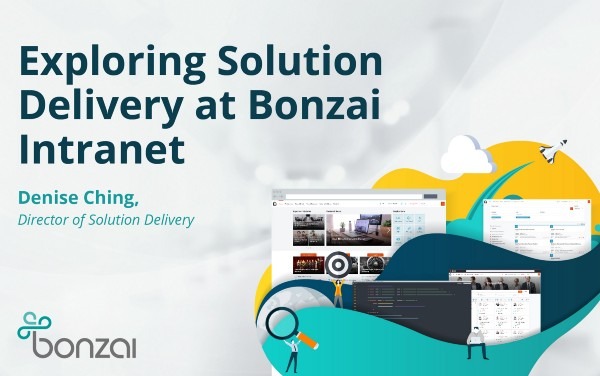A Different Approach to Solution Delivery [Interview]
inThere is nothing more satisfying than hearing your customers expressing their positive experience with your product and service delivery. We proud ourselves on the ability to come up with the Bonzai Intanet’s Solution Delivery Process to deliver successful intranet projects
deliver great Intranet solutions here at Bonzai. Today, we want to learn about the 'secret sauce' behind Bonzai Intranet Solution delivery. What is it that makes our customers so happy with the way we deliver
with Denise Ching on and how it has evolved to the way it is now.
“Denise is here to talk a little bit about the solution delivery process in the software development cycle. What’s different emerging from a consulting company to a product-based company and how the delivery process for Bonzai Intranet has changed?”
“She’ll also talk a little bit about what they’ve learned, scar tissue and what we’re doing to move forward with our product end.”

Different Approach to Solution Delivery
“So, the first question was around what’s the difference between a custom engagement versus something on Bonzai? And the main difference is, with Bonzai because it’s a productized approach, we already have functionality already built in the tool. We don’t spend time gathering requirements on functionality, so we don’t do any functional requirements as part of our process.”
“Our process is really solidified over the last four years of doing these implementations. We built in a lot of best practices and also a lot of feedback from our customers. So our process, our delivery process is proprietary. It’s also very repeatable. So every stage has specific presentations, templates, documentation, deliverables that we have all ready to go to provide to clients.”
“Of course, we tweak some of the content for specific clients. For example, tree test or IA validation tree test results, we obviously have to tweak the presentation based on the customer’s results. But for the most part, everything is very ‘template-ized’ and ready to go, ensuring consistency in delivery and quality, and that we’re always learning from every implementation.”
Does Implementation Size Matter?
Cameron: “Perfect. Do you find there’s much of a difference between smaller projects, maybe companies between 300 to 500 users, and really large scale organizations with 55,000 users?”
Ching: “Yes, of course. Doesn’t matter what size of the organization, I think everyone’s content needs and content challenges are going to be consistent.”
“But for a really big company, a multi-national company, they have challenges with a very dispersed team across different regions, different countries. So, when it comes to content, and we spend a lot of time understanding their current intranet, their current content and information, the scope of that becomes bigger, and the considerations become a little bit more complicated.”
“We have a great feature called content targeting, where you can target content based on region, for example, location, department. We can essentially set up your internet to show people only things that they would care about based on their role or their location.”
“To set that up, we have to understand how their information is structured from an organizational perspective. The bigger it gets, the more diverse the information is, and the more consideration we have to take into account when planning their information architecture.”
Solution Delivery Challenges
Cameron: “That’s great. Because it’s been a very iterative process to come up with a system that works so good that you can just deliver it time after time again by just tweaking it here and there, what are some of the challenges that you guys faced along the way?
Ching: “I think the biggest challenge we’re facing right now is because it’s ‘template-ized’ and because it’s a very streamlined approach, sometimes we have customers that have some special requirements and/or needs regarding experience with building intranets or specific SharePoint expertise may not be there for teams that are smaller or teams that have not worked with SharePoint in the past.”
“Taking that into consideration, I think we need to come up with an approach where we can adapt to customers who need a little bit more hand holding in certain areas, especially the technical areas. We know it’s a really big endeavor for every company, so I think we have to internally be able to adjust and act quickly to customers that may need a little bit more help in certain areas.”
Customer Feedback Feeds Solution Delivery
Cameron: “Do you find your team is always getting really good suggestions from customers about our product, and what happens to those suggestions?”
Ching: “Yes, we get a lot. We love our clients for that, because they always provide really good feedback throughout the whole process.”
“Many times, we will try to get that information from them throughout the whole life-cycle of the project. But most of time, they offer that information, because they want to give it to us so we can improve our processes for our future implementations and for future customers as well.
“What we do with all of that feedback, is we come back, we have lessons learned meetings within the company, and we have lessons learned meetings within our team to make sure we’re building in some key themes that we’re getting from customers.”
“We’re always very aware of what challenges customers are having, so that we can tweak our process to make sure that we’re making it easier for the next implementation and every one after that.”
Cameron: “Do you find a lot of customers have the same sorts of challenges? Does that get pretty repetitive, or do you find every organization is pretty unique?”
Similar Intranet Challenges
Ching: “The challenges, I would say, are more similar than you would think, because at the end of the day, we’re dealing with an intranet. We’re not building different types of software or applications.”
“Intranet challenges are quite consistent. Like people can’t find information, their intranet is very old, so they have a lot of old content in there. They need that cleaned up. People always say ‘search sucks’ and we have to dig into what that really means for them.”
“There’s a whole wack of things that they always talk about, and it’s quite consistent, and we try to build those answers in within the process as well, so that we can help answer some of those questions and see how we can help solve them. So we’re being a little bit more proactive with some of the things out there that they find challenging.”
Ching: “What was the second part of the question?”
Cameron: “No, that was pretty much it. Yeah, no, you’re doing good.”
Product Centric Solution Delivery
Cameron: “So if you were to give anybody a piece of advice, kind of going down this route from diverting from consulting into product, what would you say in terms of product management?”
Ching: “For firms that are switching from like a custom approach to product, it’s quite a shift. Like I personally had some challenges in the beginning, and I know our team did, because in consulting you say yes to almost everything, because everything is possible with time and money, right? You just communicate how much something costs and whether or not something is feasible, and if it’s custom, most of the time it’s feasible.”
“In product, however, we end up saying: No, but here’s a way you can configure it, or No, the product doesn’t work that way, more often than not. So, I think it’s just switching from saying yes to everything, because everything has a cost to it, to saying, No, this is how the product works, but here is a workaround, or, here are some other ways you can achieve the same requirement. It may not be exactly what you just explained, but this is very close to what you need in terms of your requirements.”
Solution Delivery Feeds Product Development
Cameron: “Basically taking all the things that you guys would typically do yourself, and then putting that into the product, and then giving the customers their own ability to solve those sorts of problems.”
Ching: “Exactly, so how we improve the product as well, it’s through feedback. During the course of implementations, if we’re getting the same ask from our customers, we log it internally. And then when it comes time for the next iteration of changes, we would prioritize them based on how many times it was asked, who asked for it. You know, just getting those data points.”
“So when we’re making improvements to the product, we have some kind of background knowledge as to why people need it. So that also fuels our development efforts and our future product improvements.”
Cameron: “Perfect. That’s great. Thanks so much, Denise.”
“That was another episode of Building Bonzai. We hope to see you in two weeks time. We’re going to have our UX designer, Mayra Pulido, as we continue exploring the topic of customer improvements and suggestions. Mayra and I are going to talk about some of the findings from our latest user testing and how we collected that data.”

It’s Time To Transform
Let us show you how much easier your work life can be with Bonzai Intranet on your team.